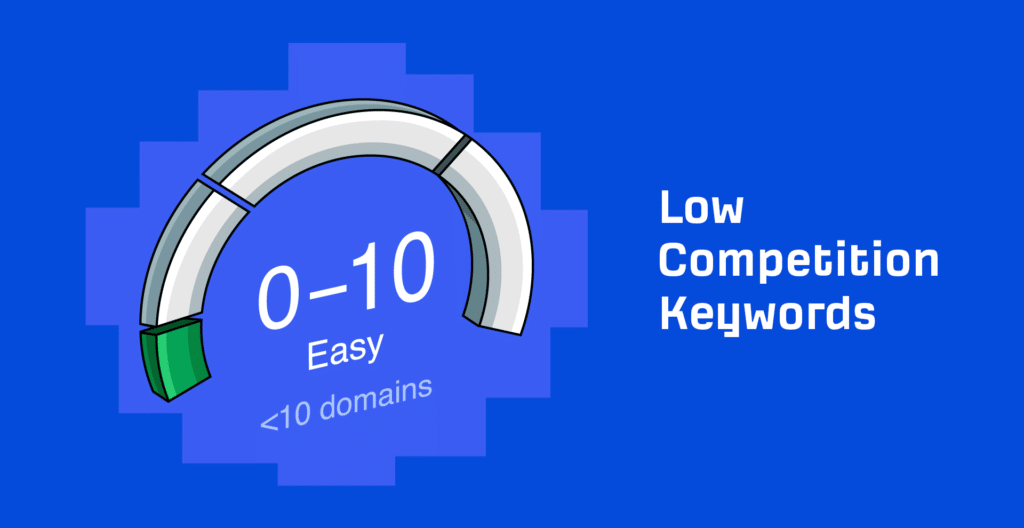If you’re looking to boost your website’s visibility quickly, focus on low-competition keywords.
These keywords are more accessible to rank for, allowing new and smaller sites to climb the search results without battling against industry giants.
Finding the right keywords is significant for SEO in today’s competitive online world. High-traffic keywords may look good, but they’re usually taken over by big companies with lots of money and power.
The fastest way to get ranked for smaller or newer websites is to find keywords with little competition that are still very important.
Not only could these keywords get you results faster, but they also bring in specific traffic that turns into sales.
Focusing on these often-overlooked gems will help you find your area and become an expert in your field more quickly.
By using the MECE (Mutually Exclusive, Collectively Exhaustive) approach, you can ensure that your keyword research is both structured and comprehensive.
This blog post will guide you through the steps to finding low-competition keywords, sparking a sense of discovery and learning.
Whether using free tools like Google Keyword Planner or more advanced ones like SEMrush and Ahrefs, this guide will help you unlock the keys to faster rankings and long-term SEO growth.
Join me as I explain how to find keywords that will help you rank higher in 2024!
Understanding Keyword Competition
To understand SEO, especially if you want to rank quickly, you need to know how to deal with keyword competition.
Keywords with low competition are search terms that not many websites are trying to rank for.
This makes it easier for younger or smaller websites to appear high on search engine results pages (SERPs). Low-competition keywords have less intense competition, making it easier to get seen faster.
Well-established sites with strong authority and a lot of backlinks control high-competition keywords.
The main difference between terms with high and low competition is how hard it is to rank for them. Keywords with a lot of competition tend to get a lot of searches but take a lot of work and authority to rank for.
On the other hand, keywords with less competition get a moderate amount of searches but are much easier to rank for, making them perfect for websites that are still building their SEO base.
New and small websites need to focus on terms with low competition.
With these keywords, you can get to the top of the search results faster, get free traffic, and build a reputation without spending much time or money. You can aim for more competitive words as your site grows.
Keyword competition is affected by many things, such as the number of websites that target a keyword, the domain authority, the quality and amount of backlinks to those sites, and how relevant the content is.
By understanding these factors, you can find chances with little competition and use them to move up in the rankings more quickly.
Benefits of Finding Low-Competition Keywords

There are many benefits to finding keywords with low competition, especially for small or new websites that want to grow quickly.
First, it’s easier for a small site to rank for keywords with low competition because they don’t have to compete with as many big sites.
This means that your site has a better chance of showing up on the first page of search results, even if it has few resources and a low domain authority. This means that it will rank higher and be seen earlier in the SERPs.
Second, the cumulative traffic effect will help you once you start ranking for terms with low competition. Your overall traffic keeps going up as you rank higher for more of these terms.
Over time, this growth will get even bigger as people start to connect your site with trustworthy, useful content.
Even though each term may not bring in a lot of traffic by itself, when you add them all together, they make a big difference in your organic traffic.
One more big benefit is that keywords with little competition often have a high chance of converting.
People who search for these keywords are usually further along in the buying process or are looking for exact answers because they are more specific and niche-focused.
This brings in more qualified visitors, which means higher conversion rates than with broad, high-competition terms.
Lastly, focusing on keywords with low competition can help you become an expert in your area.
By regularly publishing high-quality content around linked low-competition keywords, your site becomes known as an authority on the subject, which boosts your SEO overall.
This can help you build the trust you need over time so you can go after and rank for more competitive keywords.
Preparing for Keyword Research

There are many benefits to finding keywords with low competition, especially for small or new websites that want to grow quickly.
First, it’s easier for a small site to rank for keywords with low competition because they don’t have to compete with as many big sites.
This means that your site has a better chance of showing up on the first page of search results, even if it has few resources and a low domain authority.
This means that it will rank higher and be seen earlier in the SERPs.
Second, the cumulative traffic effect will help you once you start ranking for terms with low competition.
Your overall traffic keeps going up as you rank higher for more of these terms. Over time, this growth will get even bigger as people connect your site with trustworthy, useful content.
Even though each term may not bring in a lot of traffic by itself, when you add them all together, they make a big difference in your organic traffic.
Another significant benefit is that keywords with little competition often have a high chance of converting.
People who search for these keywords are usually further along in the buying process or are looking for exact answers because they are more specific and niche-focused.
This brings in more qualified visitors, which means higher conversion rates than with broad, high-competition terms.
Lastly, focusing on keywords with low competition can help you become an expert in your area.
By regularly publishing high-quality content around linked low-competition keywords, your site becomes known as an authority on the subject, which boosts your SEO overall.
This can help you build the trust you need over time so you can go after and rank for more competitive keywords.
Finding Low-Competition Keywords: Step-by-Step Process
Using Google Autocomplete for Idea Generation
Start by typing a broad keyword into Google’s search bar. As you type, Google Autocomplete will suggest related keywords based on real user queries.
These long-tail keyword suggestions often have lower competition because they reflect niche search intents.
Make sure to explore multiple variations to uncover untapped opportunities.
Exploring Google's "People Also Ask" Feature
The “People Also Ask” (PAA) section in search results shows commonly asked questions related to your query.
These questions provide insights into specific user problems and can lead to low-competition keyword ideas.
By addressing these questions directly in your content, you can rank for question-based queries that tend to be less competitive.
Leveraging Google Trends for Hidden Opportunities
Google Trends helps you analyze keyword popularity over time and by location.
Look for keywords with increasing search volume but low competition.
You can also find trending topics in specific niches, helping you capitalize on emerging opportunities before they become highly competitive.
Competitor Analysis for Untapped Keyword Ideas
Analyze your competitors’ content using tools like Semrush or Ahrefs. Identify keywords they rank for that you don’t.
By focusing on low-competition, high-intent keywords that competitors are missing, you can carve out your own ranking opportunities in your niche.
Find Easy-to-Rank Keywords Using Mangools' KWFinder
KWFinder is known for its user-friendly interface and accurate keyword difficulty scores.
By filtering keywords based on low difficulty, you can easily find terms that are within your reach to rank for.
Focus on keywords with moderate search volume and low difficulty to target terms that will drive traffic with minimal effort.
Using Semrush's Keyword Magic Tool to Find Low-Difficulty Keywords
Semrush’s Keyword Magic Tool allows you to filter keywords by difficulty.
By focusing on keywords with low difficulty scores, you can prioritize the ones that have a higher chance of ranking quickly.
The tool also provides related keywords and questions, which can help expand your keyword list with easy-to-rank terms.
Analyzing Your Competitors' Websites to Find Low-Hanging Fruits
Use tools like Ahrefs or Moz to run competitor site audits. Look for pages or blog posts on your competitor’s site that rank for keywords but have low authority or poor optimization.
These are opportunities to create better content and outrank them for low-competition keywords they may be missing or underutilizing.
Uncover Overlooked Keywords on Reddit
Reddit is an excellent platform to find niche-specific, low-competition keywords.
Use Reddit search or tools like Keywords Everywhere to scan for frequently asked questions or discussions in subreddits related to your niche.
Keywords found here often have little competition and can help you target very specific search intents.
Use Google Search Console to Reverse Engineer Keywords You're Already Ranking for
Check Google Search Console to find keywords for which your site is already ranking but in lower positions (e.g., page two or three).
By optimizing for these terms—especially those with low competition—you can boost your rankings and attract more traffic quickly.
YouTube Autocomplete
Similar to Google Autocomplete, YouTube’s search bar provides valuable keyword suggestions when you start typing a phrase.
These are especially useful for video content creation, but many of these long-tail keywords are also low-competition terms you can target in written content, as YouTube and Google search results often overlap.
This multi-step process gives you a comprehensive approach to finding low-competition keywords that rank faster, helping you strategically optimize your content for 2024.
Advanced Techniques for Discovering Low-Competition Keywords

Long-Tail Keywords: A Goldmine of Low Competition
Long-tail keywords, which are typically three to five-word phrases, have lower search volumes but often reflect specific user intents.
These keywords face less competition because they target niche queries.
By optimizing for long-tail keywords, you can attract a more focused audience and rank faster due to the lower difficulty.
For example, instead of targeting “shoes,” you could target “best running shoes for flat feet.”
How to Use Question-Based Keywords to Rank Quickly
Question-based keywords are phrases that users search for to find direct answers, such as “how to grow succulents indoors.”
These keywords often trigger featured snippets or appear in the “People Also Ask” section, and since many sites overlook them, they tend to have lower competition.
Creating content that comprehensively answers these questions lets you quickly rank and capture organic traffic.
Identifying Keywords with Low SERP Features (No Ads, Videos, etc.)
Some keywords have minimal or no SERP (Search Engine Results Page) features like ads, videos, or image packs.
These keywords present an excellent opportunity for ranking because the competition from different media types is lower.
Tools like Ahrefs or Semrush can help you identify these keywords by analyzing the SERP layout for particular queries, allowing you to focus on less cluttered results pages.
Exploring Localized Keywords for Niche Audiences
Localized keywords, such as “best Italian restaurants in San Diego,” target specific geographic areas.
These keywords are highly effective for businesses or content targeting regional audiences.
Since they cater to local search intent, the competition is typically much lower compared to broader keywords, making it easier to rank for and capture niche traffic.
Conduct a Content Gap Analysis to Intercept Traffic From Your Competitors
Content gap analysis involves comparing your site’s keyword rankings to those of competitors.
By identifying keywords your competitors are ranking for but you are not, you can spot gaps in your content.
Tools like Ahrefs’ Content Gap feature make this process simple.
Filling these gaps allows you to intercept competitor traffic with optimized, high-quality content targeting low-competition keywords.
Discover Location-Based Keywords
In addition to localized keywords, location-based keywords are broader search terms tied to specific areas or regions.
These include phrases like “plumber near me” or “best cafes in Los Angeles.” Such keywords are valuable for businesses with physical locations or service areas.
Targeting these terms can help you rank in local search results, particularly for mobile users, where competition is lower.
Applying these advanced techniques can uncover hidden, low-competition keyword opportunities that can propel your site to rank faster and more effectively in 2024.
How to Find Low Competition Keywords with High Traffic
Finding low-competition keywords is great—but finding low competition keywords with high traffic is the real game-changer.
These are the golden nuggets of SEO that allow you to rank quickly without battling big players in your niche.
Here’s how you can uncover these hidden gems and apply them effectively across your blog, website, and even YouTube channel.
1. Use Tools That Focus on Keyword Difficulty and Volume
To begin with, look for tools like Ubersuggest, LowFruits.io, Keyword Chef, or Google Keyword Planner.
These platforms not only show keyword difficulty but also offer volume metrics—helping you strike that perfect balance.
Simply search a seed keyword, then filter for low competition (KD below 20 or 30) and high search volume. This is the sweet spot where traffic meets opportunity.
2. How to Find Low Competition High Volume Keywords for Free
If you’re starting out and want a free solution, use Google Search Autocomplete, People Also Ask, and Reddit or Quora discussions. These platforms reveal real user queries.
Pair them with a free tool like Keyword Surfer Chrome Extension, which gives you traffic estimates right inside Google search.
This combo can help you spot low competition keywords with high traffic for free.
3. Finding Keywords for Your Website
When you’re looking for low competition keywords for your website, consider long-tail variations specific to your niche. For example, instead of targeting “SEO tools,” go for “best free SEO tools for beginners 2025”.
Tools like Answer the Public and AlsoAsked can show question-based queries that are both low in competition and high in traffic potential.
4. Finding Low Competition Keywords for YouTube
For video creators, use tools like TubeBuddy or VidIQ to find low competition keywords with high traffic for YouTube. These tools show weighted competition scores based on your channel.
Also, search your topic on YouTube and check the top-ranking videos. If they have low views but still rank high, that keyword has low competition potential.
5. Try a Dedicated Low Competition Keyword Finder
Want to simplify the process? Use a low competition keyword finder like LowFruits.io or KeywordChef.
These tools scan the SERPs for weak spots—such as forums, Quora, or outdated blogs ranking in the top 10—indicating a real chance for you to rank fast with your content.
🔍 Pro Tip: Always validate your keywords by checking the top 10 results manually. If you see outdated content, low-authority domains, or question-based results, it’s a sign that you can outrank them with quality content.
Evaluating Keyword Competition
How to Analyze Keyword Difficulty Scores
Most SEO tools like Semrush, Ahrefs, and Mangools provide a keyword difficulty (KD) score, which indicates how hard it is to rank for a particular keyword.
The score typically ranges from 0 to 100, with higher numbers indicating more competition.
When evaluating keywords, aim for those with lower difficulty scores (generally below 40) as these are easier to rank for, especially if you have a newer or smaller website.
These scores help prioritize keywords that offer a balance between ranking potential and effort.
Using Domain Authority (DA) to Gauge Competitor Strength
Domain Authority (DA), developed by Moz, measures a website’s ability to rank in search engines based on factors like backlink profile, trustworthiness, and overall SEO performance.
By comparing your DA with competitors ranking for your target keyword, you can assess whether you have a realistic chance of outranking them.
For low-competition keywords, look for SERPs where competitors have a DA similar to or lower than yours, as this indicates a better opportunity to rank.
Examining the Backlink Profile of Top-Ranking Pages
Backlinks play a significant role in search rankings. When evaluating keyword competition, examine the backlink profiles of the top-ranking pages.
Tools like Ahrefs or Majestic allow you to see how many backlinks these pages have and the quality of those links.
If top-ranking pages have a weak or minimal backlink profile, it’s a good indicator that you can outrank them without needing a large number of links.
This is especially helpful for finding low-competition keywords where backlink requirements are lower.
Assessing Search Volume: Balancing Volume and Competition
While low-competition keywords are easier to rank for, it’s essential to ensure they also have enough search volume to drive meaningful traffic.
A keyword with low difficulty but extremely low search volume may not be worth targeting. Use tools like Google Keyword Planner or Semrush to check search volume.
Aim for keywords with moderate search volume and low competition, striking a balance between traffic potential and ease of ranking.
Keywords with 100-1,000 monthly searches often provide a sweet spot for low-competition ranking opportunities.
By evaluating keyword competition through these steps, you can strategically target keywords that offer the best chances of ranking quickly, while still driving meaningful traffic in 2024.
Free Tools for Low-Competition Keyword Discovery
Google Keyword Planner: Features and Limitations
Google Keyword Planner is a free tool provided by Google Ads that helps users discover keywords and assess their search volumes.
One of its key features is the ability to filter keywords by competition level—low, medium, or high—making it easier to find low-competition keywords.
However, it has some limitations, such as providing broad search volume ranges and primarily focusing on advertisers rather than organic search marketers.
This means it may not always be the best tool for precise, low-competition keyword discovery.
Ubersuggest: Finding Easy-to-Rank Keywords
Ubersuggest, created by Neil Patel, is a freemium tool that excels in identifying easy-to-rank keywords.
It offers a keyword difficulty score, search volume data, and related keyword suggestions.
You can easily find terms with low competition by filtering results for keywords with low difficulty scores.
The free version provides a good number of searches and insights, making it a go-to tool for discovering keywords with minimal effort.
KeywordTool.io: Analyzing Long-Tail Variations
KeywordTool.io is a free alternative to Google Autocomplete that generates hundreds of long-tail keyword suggestions based on your input.
It pulls data from multiple search engines, including Google, YouTube, and Bing, allowing you to explore variations that may have less competition.
The free version doesn’t provide search volume or difficulty metrics, but it’s a great starting point for brainstorming long-tail keywords, which tend to have lower competition.
AnswerThePublic: Uncovering Question-Based Keywords
AnswerThePublic is a visual tool that aggregates questions, prepositions, and comparisons people commonly ask related to a particular keyword.
These question-based keywords are often less competitive and can be perfect for targeting specific user intents.
The tool provides a comprehensive view of the queries people are searching for, helping you find low-competition opportunities in the form of questions you can answer in your content.
These free tools offer a solid foundation for discovering low-competition keywords that can help your content rank faster, even without investing in premium SEO tools.
Paid Tools for Finding Low-Competition Keywords
SEMrush: In-Depth Competitor Keyword Analysis
SEMrush is a powerful SEO tool that excels in competitor keyword analysis.
By entering a competitor’s domain, SEMrush provides a detailed list of keywords they rank for, along with search volume, keyword difficulty, and traffic potential.
This enables you to uncover low-competition keywords that your competitors may be missing or underutilizing.
SEMrush also allows you to track keyword rankings and spot opportunities for keywords with low difficulty but high intent.
Ahrefs: Analyzing Keyword Difficulty and SERP Overviews
Ahrefs is widely known for its accurate keyword difficulty scores and detailed SERP (Search Engine Results Page) overviews.
The Keyword Explorer tool not only shows keyword difficulty but also the number of backlinks required to rank for a keyword, giving you a clear idea of how competitive a term is.
Ahrefs also displays the top-ranking pages for each keyword, allowing you to analyze their authority, backlink profiles, and other factors, making it easier to target low-competition terms that can rank faster.
Moz Keyword Explorer: Prioritizing Low-Difficulty Keywords
Moz’s Keyword Explorer is another excellent tool for finding low-competition keywords.
One of its standout features is the “Priority” score, which combines search volume, keyword difficulty, and your site’s likelihood of ranking.
By filtering keywords with low difficulty and a high priority score, you can easily focus on keywords that offer the best chances of ranking with minimal effort.
This feature makes Moz particularly useful for narrowing down your keyword list to low-competition, high-potential terms.
KWFinder: Identifying Easy-to-Rank Keywords Quickly
KWFinder by Mangools is designed specifically for identifying easy-to-rank keywords with low competition.
It provides a straightforward keyword difficulty score alongside search volume, making it easy to spot opportunities at a glance.
KWFinder also displays SERP analysis, showing top-ranking pages and their SEO metrics, which helps you quickly assess whether a keyword is within reach.
Its user-friendly interface and accuracy in finding low-competition keywords make it a favorite among SEO professionals.
These paid tools provide comprehensive insights into keyword difficulty, competitor analysis, and SERP overviews, helping you uncover low-competition keywords that can drive traffic and rankings in 2024.
Refining Your Keyword List
Filtering Keywords by Search Intent
Search intent is the purpose behind a user’s query, whether it’s informational, navigational, transactional, or commercial.
When refining your keyword list, ensure that the keywords align with the type of content you’re creating.
For example, if your content is a product review, focus on transactional or commercial intent keywords, like “best laptop for video editing,” rather than purely informational terms.
Prioritizing search intent ensures that your keywords attract the right audience and lead to better engagement.
Prioritizing Keywords with Low Competition and High Relevance
After analyzing keyword difficulty, prioritize keywords that strike a balance between low competition and high relevance to your content or business.
These are keywords that you can realistically rank for while driving traffic from users who are likely to convert.
Relevance is key—targeting low-competition keywords is only effective if they match your audience’s needs and search behaviors.
Grouping Keywords for Topic Clusters and Content Pillars
Rather than focusing on single keywords, group related keywords into topic clusters.
This approach allows you to build content pillars—comprehensive, authoritative pages that cover a broad topic and link to related subtopics.
Organizing your keywords in this way creates stronger internal linking and improves your chances of ranking for multiple related terms, while signaling to search engines that your content provides value across an entire subject area.
How to Avoid Keyword Cannibalization
Keyword cannibalization occurs when multiple pages on your site target the same keyword, causing them to compete against each other in the search results.
To avoid this, make sure each keyword or keyword group is assigned to a unique page with a distinct focus.
Use SEO tools to audit your site and identify any instances of cannibalization, then consolidate or refine your content to resolve conflicts and improve rankings.
By refining your keyword list with these techniques, you can enhance your SEO strategy and maximize your chances of ranking quickly for low-competition keywords in 2024.
Implementing Low-Competition Keywords in Your Content
Optimizing On-Page SEO for Quick Ranking
Once you’ve identified low-competition keywords, implement them strategically in key on-page SEO elements.
This includes placing your primary keyword in the title, URL, meta description, headers (H1, H2, etc.), and alt text for images.
Be sure also to use variations of the keyword throughout the body content.
Proper on-page optimization increases your chances of ranking quickly by signaling to search engines that your content is relevant and comprehensive.
Crafting Content That Aligns with Search Intent
Creating content that matches the user’s search intent is crucial for ranking fast.
Your content should fulfill that need whether the intent is informational, transactional, or navigational.
For example, if the search intent is informational, provide detailed guides or how-tos. If it’s transactional, focus on product comparisons or reviews.
Ensuring your content directly aligns with the user’s intent increases the likelihood of satisfying both the user and search engines.
Using Keywords Naturally: Avoiding Keyword Stuffing
While using your low-competition keywords is essential, avoid overloading your content with them—a practice known as keyword stuffing.
Instead, aim for natural keyword placement by integrating them organically into your writing.
Use related phrases and synonyms to help search engines understand the context without relying solely on the main keyword.
This not only improves readability but also prevents penalties from search engines.
Structuring Content for Featured Snippets and Rich Results
Structure your content with clear, concise answers to common questions to boost your chances of appearing in featured snippets or other rich results. Use bullet points, numbered lists, and short paragraphs to make your content easier to scan.
Incorporating well-structured headings (H2 and H3) with relevant keywords also helps search engines better understand the organization of your content, increasing the chances of appearing in SERP features that can drive more visibility and clicks.
By implementing these techniques, you can ensure that your content is optimized to rank quickly for low-competition keywords in 2024, driving targeted traffic to your site.
Tracking and Measuring Success
Setting Up Google Search Console for Keyword Tracking
Google Search Console is an essential free tool for tracking the performance of your keywords.
Once set up, it provides detailed reports on which keywords are driving impressions, clicks, and rankings.
By regularly reviewing the “Performance” section, you can track your low-competition keywords and see how they rank over time.
It also helps you identify any keyword opportunities or underperforming terms that need optimization.
Monitoring Keyword Rankings with SEO Tools
SEO tools like Semrush, Ahrefs, or Moz are excellent for tracking keyword rankings over time.
These tools provide real-time data on how your chosen low-competition keywords are performing in the SERPs.
By setting up keyword tracking, you can monitor shifts in rankings, observe the impact of your SEO efforts, and quickly identify any fluctuations that may require action.
Measuring Organic Traffic Growth from Low-Competition Keywords
To gauge the success of your low-competition keyword strategy, analyze organic traffic growth using tools like Google Analytics.
Look for increases in traffic to specific pages optimized for these keywords.
Pay attention to metrics such as time on page, bounce rate, and conversions to ensure the traffic is not only growing but also engaging and converting effectively.
Adjusting Your Keyword Strategy Based on Results
SEO is an ongoing process, and tracking results helps you refine your strategy.
If certain low-competition keywords aren’t performing as expected, consider tweaking your content or exploring new keywords.
Conversely, if a keyword is driving significant traffic, you can double down by creating related content or optimizing further.
Regularly adjusting your strategy based on data ensures you stay competitive and continue ranking for the most valuable low-competition keywords.
By tracking and measuring your keyword performance, you can continuously refine your approach, ensuring sustained growth and success with low-competition keywords in 2024.
Common Pitfalls to Avoid in Low-Competition Keyword Research
Overemphasizing Search Volume Over Relevance
A common mistake is focusing too much on search volume without considering how relevant the keyword is to your content or audience.
High-volume keywords may seem attractive, but if they don’t align with what your audience is searching for, they won’t drive meaningful traffic or conversions.
Prioritize keywords that are closely related to your niche and provide value to your readers, even if their search volume is lower.
Ignoring User Intent in Keyword Selection
Keywords that don’t match user intent can result in poor engagement and higher bounce rates.
For example, targeting a transactional keyword for an informational blog post will confuse users and lead to lower rankings.
Always ensure your content aligns with the intent behind the keyword, whether it’s informational, commercial, or navigational, to provide a satisfying user experience.
Relying Solely on Tools without Manual Research
SEO tools are invaluable for finding keywords, but relying entirely on them without conducting manual research can limit your success.
Tools might miss nuances in user behavior or trending queries. Supplement your keyword research with manual methods like exploring forums, Reddit, and social media, or using Google Autocomplete to uncover less obvious but valuable low-competition keywords.
Neglecting Ongoing Keyword Updates and Trends
SEO is not a one-time task—ignoring the need for ongoing keyword updates can lead to missed opportunities.
Trends shift, new search behaviors emerge, and competition can increase over time.
Regularly revisiting your keyword list, analyzing new trends using tools like Google Trends, and adapting your strategy will keep your content fresh and competitive in the search rankings.
Avoiding these common pitfalls will help ensure your low-competition keyword research is effective, driving relevant, sustainable traffic to your site in 2024.
Conclusion: Low-Competition Keywords
Finding and targeting low-competition keywords is an essential strategy for websites, especially new and small ones, to gain traction in the crowded SEO landscape.
By understanding the nuances of keyword competition, leveraging both free and paid tools, and aligning keywords with search intent, you can improve your chances of ranking quickly.
Key takeaways include:
- The importance of focusing on long-tail and question-based keywords.
- Evaluating competition carefully.
- Optimizing on-page SEO to ensure content meets user needs and search engine requirements.
Continuous keyword research and optimization are crucial.
Regularly updating your keyword strategy will help you stay ahead as trends evolve and competition fluctuates.
Monitoring your rankings, measuring traffic growth, and refining your approach based on performance are necessary steps to ensure your SEO efforts yield long-term results.
By prioritizing low-competition keywords, you can boost your visibility, drive targeted traffic, and establish topical authority in your niche.
This approach lays a strong foundation for long-term SEO success, positioning your website for sustained growth in 2024 and beyond.
FAQs: Low-Competition Keywords
How Do Low-Competition Keywords Help New Websites Rank Faster?
Low-competition keywords typically have fewer competing pages, making it easier for new websites to achieve higher rankings and visibility in search results.
How Often Should I Update My Keyword Research?
You should update your keyword research at least quarterly, or more frequently if trends change in your industry or your content strategy evolves.
Can Low-Competition Keywords Drive Substantial Traffic?
Yes, while individual low-competition keywords may have lower search volumes, collectively targeting multiple such keywords can lead to significant traffic over time.
What Are the Best Tools for Discovering Low-Competition Keywords?
Some of the best tools include Google Keyword Planner, Ubersuggest, KWFinder, SEMrush, and Ahrefs.
What is a low competition keyword?
A low competition keyword is a search term that has fewer pages competing for top rankings, making it easier to rank for that keyword.
How to find low competition keywords for free?
You can use free tools like Google Keyword Planner, Ubersuggest, AnswerThePublic, and Google Autocomplete to identify low-competition keywords.
What are competitor keywords?
Competitor keywords are search terms that your competitors are targeting in their content to attract traffic, often revealing opportunities for your own keyword strategy.
How to find high CPC low competition keywords?
Use tools like SEMrush or Ahrefs to filter keywords by both cost-per-click (CPC) and keyword difficulty, identifying those with high CPC and low competition.
What's an example of a low intent keyword?
An example of a low intent keyword is "what is SEO," as it typically indicates a user looking for information rather than making a purchase or taking immediate action.










